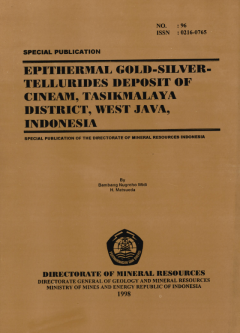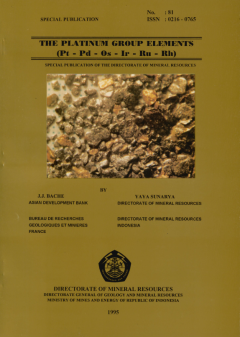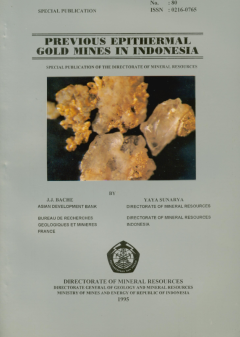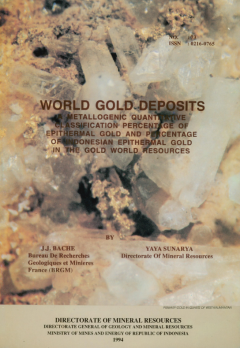Ditapis dengan

Ephitermal gold-silver-tellurides deposit of cineam, Tasikmalaya District, We…
Study on epithermal gold and silver deposits which is located at the Cineam area, Tasikmalaya has given a new perspective, particularly in term of mineralization zone occurring in the eastern ofsouthern West Java Mountain Range. Geologically, the deposits are hosted by Oligo - Miocene Jampang Formation volcanic rock which principally consist ofandesitic to basaltic lava, volcanic …
- Edisi
- -
- ISBN/ISSN
- 0216-0765
- Deskripsi Fisik
- 26p.,ill. 14 x 21 cm
- Judul Seri
- -
- No. Panggil
- PK No. 96

The Platinum group elements (Pt-Pd-Os-Ir-Ru-Rh)
These are ring complexes several kilometers accross encased orogenic zone characterised by some units similar to those of Island arcs. No bedding is apparent in the field.Their age ranges from Devonian to Cretaceous. Their geochemistry (magma type) and metallogeny (PGE element distribution and type of metal) are largely unknown. The known mineralization associated with these complexes…
- Edisi
- -
- ISBN/ISSN
- 0216-0765
- Deskripsi Fisik
- 27p,.ill. 22 x 19 cm
- Judul Seri
- -
- No. Panggil
- PK No. 81

Previous epithermal gold mines in Indonesia
The known occurences are almost located in the Barisan Mountain area. Most deposit are hosted in Tertiary volcanics and are considered to be late in Tertiary in age A number of areas contain gold mineralization in quartz stringers in pre Tertiary metamorphic rocks. The older gold deposits tend to be more common in the northern part of Sumatera where placer are also more c…
- Edisi
- -
- ISBN/ISSN
- 0216-0765
- Deskripsi Fisik
- 32p,.ill. 22 x 19 cm
- Judul Seri
- -
- No. Panggil
- PK No. 80

World gold deposits A metallogenc quantitative classification perecentage of …
A notable feature of such deposts in eugeosynclinal rocks, is the spatial associati• on of auriferous deposits and those of the polymetallic sulphides ores although the deposits themselves occur at different stratigraphic levels. Such associations are exem• plified in the Archaean of Canada. Furthermore gold is often a by-product of the polymetallic sulphide ores and sul…
- Edisi
- -
- ISBN/ISSN
- 0216-0765
- Deskripsi Fisik
- 19p.,ill. 14 x 21 cm
- Judul Seri
- -
- No. Panggil
- PK No. 73

The application of induced polarization and magnetic methods in the ephiterma…
This paper discusses one of the successful application of induced polarization (IP) and magnetic methods to an epithermal gold prospect of Mt. Subang, West Jawa, Indonesia. The main host-rock for the metallic minerals in the epithermal gold deposit of Mt. Subang is an altered andesite. In this case study, therefore, the magnetic method is used to map the zone of altered andesite and to confirm …
- Edisi
- -
- ISBN/ISSN
- 0216-0765
- Deskripsi Fisik
- 22p.,ill. 14 x 21 cm
- Judul Seri
- -
- No. Panggil
- PK No. 34

six months reporet primary gold eksploration projrect for partbof kp area (kw…
- Edisi
- -
- ISBN/ISSN
- -
- Deskripsi Fisik
- 14 halaman , ada 2 peta , tak berwarna.
- Judul Seri
- -
- No. Panggil
- PMB LE 1997-13

Ephitermal Gold Mineralizations
- Edisi
- -
- ISBN/ISSN
- -
- Deskripsi Fisik
- 88 p. : ill. ; 21.5 cm
- Judul Seri
- -
- No. Panggil
- PMB LU 1987 - 11

Proceedings of Sulawesi mineral resources seminar, 28 - 29 November, 2011 Man…
- Edisi
- -
- ISBN/ISSN
- -
- Deskripsi Fisik
- iii, 332 p. : ill. ; 21 cm
- Judul Seri
- -
- No. Panggil
- PMB 01 - 2011 Prosiding

Ore and alteration types of the gold and copper mineralization in the lascogo…
- Edisi
- -
- ISBN/ISSN
- -
- Deskripsi Fisik
- 8 p. : ill. ; 21 cm
- Judul Seri
- -
- No. Panggil
- PMB 88 - 2019 Fungsional
 Karya Umum
Karya Umum  Filsafat
Filsafat  Agama
Agama  Ilmu-ilmu Sosial
Ilmu-ilmu Sosial  Bahasa
Bahasa  Ilmu-ilmu Murni
Ilmu-ilmu Murni  Ilmu-ilmu Terapan
Ilmu-ilmu Terapan  Kesenian, Hiburan, dan Olahraga
Kesenian, Hiburan, dan Olahraga  Kesusastraan
Kesusastraan  Geografi dan Sejarah
Geografi dan Sejarah